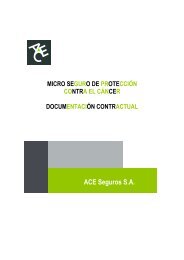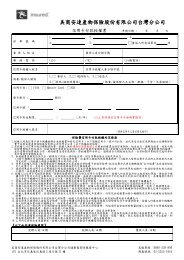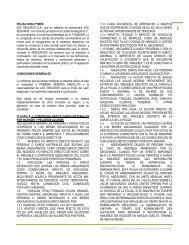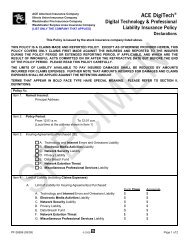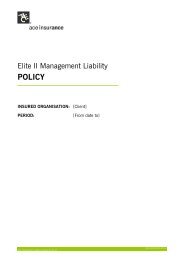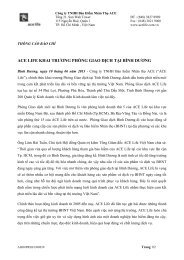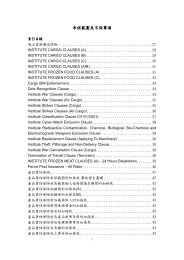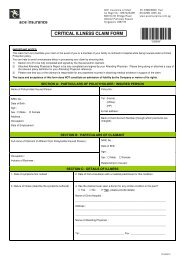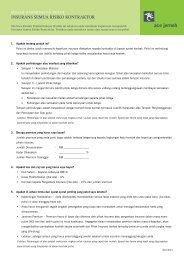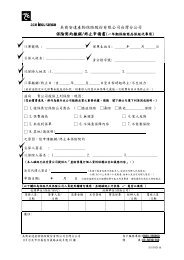M&A Risk MAnAgeMent: CollAteRAl liAbilities And ... - ACE Group
M&A Risk MAnAgeMent: CollAteRAl liAbilities And ... - ACE Group
M&A Risk MAnAgeMent: CollAteRAl liAbilities And ... - ACE Group
Create successful ePaper yourself
Turn your PDF publications into a flip-book with our unique Google optimized e-Paper software.
M&A <strong>Risk</strong> Management:<br />
Collateral Liabilities<br />
and Solutions<br />
By Seth Gillston, with commentary from Tom Kim
M&A <strong>Risk</strong> Management:<br />
Collateral Liabilities<br />
and Solutions<br />
Seth Gillston with commentary from Tom Kim March 2013<br />
Executive Summary<br />
When global companies and private equity firms engage in<br />
mergers and acquisitions, they often confront obligations to<br />
provide collateral that are associated with the target entity’s<br />
insurance programs. These obligations specifically involve past<br />
and ongoing financial risks emanating from the deductibles or<br />
self-insured retentions that arise under the target entity’s workers<br />
compensation, automobile liability and general liability policies.<br />
These liabilities, in some cases, may be absorbed by the target<br />
entity’s wholly-owned captive insurance facility. Different state<br />
regulatory requirements can further complicate the treatment of<br />
these obligations to provide collateral.<br />
Similar liabilities affect the acquirer in instances where the target<br />
entity has substantial surety bond requirements, which now<br />
become the acquirer’s obligation to fulfill and collateralize. How<br />
best to address such collateral responsibilities from an efficient<br />
risk transfer standpoint is the subject of this <strong>ACE</strong> Progress Report.<br />
The paper builds upon a series of other <strong>ACE</strong> Progress Reports<br />
assessing M&A risks.<br />
Global Mergers & Acquisitions<br />
Global mergers and acquisitions are expected to rise significantly<br />
through 2013, given anticipated corporate profit increases in<br />
virtually every industry sector. “The world’s largest companies are<br />
bouncing back … with profit expectations up seven percent from<br />
six months ago,” said David Simpson, KPMG Global Head of<br />
Mergers & Acquisitions. “The capacity to transact continues to<br />
rise as companies pay down debt. Overall net debt is forecast to<br />
drop 12 percent globally, and global net debt to EBITDA ratios are<br />
expected to fall 19 percent over the next year.” 1 Already, 2013 is<br />
off to a robust start with respect to M&A transactions. In January,<br />
it was reported that Michael Dell and private equity group, Silver<br />
Lake Management, were in talks to take Dell Inc. private; while in<br />
February, Berkshire Hathaway and 3G Capital announced its<br />
acquisition of H. J. Heinz and Co.<br />
Companies with strong balance sheets, inexpensive debt and<br />
significant capital are expected to continue to pursue growth<br />
through mergers and acquisitions, despite the fluid economic<br />
climate. There has also been a recent trend for large<br />
conglomerates to break apart and focus on core businesses. In<br />
both cases, potential purchasers need to perform due diligence of<br />
the target entities’ ongoing liabilities, with respect to their retained<br />
self-insured risk or deductible reimbursement obligations.<br />
These financial obligations in an M&A context typically arise from<br />
exposures relating to primary liability lines of insurance, such as<br />
workers compensation, automobile liability and general liability. In<br />
some cases, the target company may have transferred these loss<br />
exposures to a company-owned captive, an insurance company<br />
that insures the risk of the parent organization and its affiliates.<br />
Vital considerations in M&A due diligence are to address these<br />
exposures in a cost-effective manner and to protect the entity<br />
from the potential volatility of these liabilities, i.e., their adverse or<br />
unanticipated loss development.<br />
Project planners should also work with their<br />
insurers to determine the most effective<br />
risk management strategies before a<br />
project begins and while it’s being built.<br />
Corporate risk managers understand that the assumption of<br />
post-transaction financial liabilities are quite common and require<br />
careful consideration. “In many of the industry sectors we look at<br />
from an acquisition standpoint—health care, manufacturing, retail,<br />
energy—obligations to provide collateral can be a material issue,”<br />
said Thomas Kim, Global <strong>Risk</strong> Manager at global investment firm<br />
KKR (Kohlberg Kravis Roberts & Co. L.P. together with its affiliates,<br />
KKR) in New York. “Insurance related collateral and guarantees are<br />
one of the top five insurance due diligence items. ”2<br />
01
M&A <strong>Risk</strong> Management: Collateral Liabilities and Solutions<br />
Obligations to Provide Collateral<br />
Mr. Kim provided an example of the financial impact of an<br />
obligation to provide collateral in the context of general liability<br />
and workers compensation. “We may be looking to buy a retail<br />
chain,” he said. “The target company may have thousands of<br />
employees lifting boxes and customers coming in and out of its<br />
stores on a daily basis, and workers compensation and slip and<br />
fall claims can be quite frequent. As risk managers, it is our<br />
responsibility to understand the frequency and financial severity<br />
of such claims, how to best prevent and manage occurrences,<br />
and how the target company is currently valuing the ultimate cost<br />
of these claims and financing them. Do they self-insure these<br />
liabilities Do they buy a large deductible program from an<br />
insurance company Do they finance these liabilities through a<br />
company-owned captive These are all important issues related<br />
to collateral that need to be understood prior to signing up a deal<br />
to purchase the target company.”<br />
In such cases, the risk manager will identify strategies to contain<br />
or reduce the target’s collateral obligations with an insurance<br />
broker and specialty M&A insurance company. Mr. Kim said, “The<br />
insurer will want collateral, typically a letter of credit, to backstop<br />
these self-insured financial obligations. The reason is because<br />
under a deductible structure, the insurer is obligated to pay losses<br />
within the deductible and then get reimbursed from the insured. If<br />
an insured were unable to reimburse the insurer, the insurer would<br />
be on the hook, so they want collateral for those obligations.” He<br />
continued, “As we inherit the existing program from the seller, we<br />
may want to review our options with an insurer to buy out the<br />
existing liabilities and thus reduce our collateral obligations.”<br />
The widespread use of letters of credit (LOC) to secure the<br />
payment of potential future losses has its drawbacks, however.<br />
For instance, letters of credit can tie up huge amounts of the<br />
acquirer’s capital—it is not uncommon for a target entity’s selfinsured<br />
financial obligations to reach into the tens of millions of<br />
dollars, Mr. Kim noted.<br />
Both the long-tail nature of workers compensation claims and the<br />
potential latency of claims illustrate the issue. As an example of<br />
this distinctiveness, he cited the risk of an employee who is<br />
exposed to a latent disease at the worksite and does not<br />
experience health issues for 20 or 30 years, at which point he or<br />
she then files a claim for which lifetime care would be necessary.<br />
Mr. Kim stated, “That’s the complication. It can take a significant<br />
amount of time for the liabilities to manifest themselves and the<br />
payout could be over a long period.”<br />
“States’ rules on posting security vary. Some states require 100<br />
percent letters of credit to match the amount of estimated total<br />
incurred losses, while others do not. A company that posts zero or<br />
few LOCs prior to the sale may require significant amounts of<br />
LOCs after the sale depending on the post-closing capital<br />
structure.” Thus, there may be an obligation to provide collateral,<br />
not only to an insurer (securing liabilities in other states), but also<br />
to the state in which the target company is a qualified<br />
self-insured.<br />
Failing to appreciate the nuances of a collateral obligation can be<br />
problematic in a merger or acquisition, Mr. Kim added. A letter of<br />
credit is not the only or the most efficient, cost-effective way of<br />
collateralizing post-transaction self-insured liabilities. Other<br />
financial arrangements, such as Loss Portfolio Transfers (LPT),<br />
Allocation and Assumption Agreements, or even a trust account<br />
through which a private equity firm can cross-collateralize its<br />
entire portfolio’s aggregate self-insured financial exposures, are<br />
other ways to manage an acquirer’s obligation to provide<br />
collateral. The latter alternative can also be an effective way for an<br />
insurance carrier to secure a private equity company’s surety<br />
bond obligations. Each of these solutions is addressed in the next<br />
section of this report.<br />
Mr. Kim provided an example regarding a surety obligation in an<br />
M&A situation. “Say a private equity firm is looking to acquire a<br />
service provider that contracts with state government entities and<br />
is required to post surety bonds guaranteeing the performance<br />
and completion of work,” he explained.<br />
“If for some reason, halfway through the project the company<br />
cannot complete the contracted work, then the surety bond<br />
comes into play to protect the customer from financial risk. Prior<br />
to the acquisition, the company may only post minimal collateral<br />
for this surety. The insurer may use the acquisition as an<br />
opportunity to review the credit profile of the company and may<br />
require it to post additional collateral, potentially up to 100 percent<br />
of the bond. When this change is equal to millions of dollars of<br />
new collateral, it can materially impact the economics of the deal.”<br />
Another nuance is the statutory treatment of workers<br />
compensation. Each state has its own regulations for providing<br />
wage replacement and medical benefits to employees injured in<br />
the course of employment. In certain states, a company can apply<br />
to opt out of buying commercial workers compensation insurance<br />
and instead self-insure the financial loss exposure. Added Mr. Kim,<br />
02
M&A <strong>Risk</strong> Management: Collateral Liabilities and Solutions<br />
Methods to Manage a Target’s Collateral Obligations<br />
Loss Portfolio Transfers<br />
In seeking to ring-fence the obligations imposed by a target’s<br />
self-insured retentions or deductible liabilities, an LPT product<br />
presents optimum efficiency and cost-effectiveness. Such<br />
products also protect from adverse loss development and can<br />
reduce the amount of collateral posted with an insurance<br />
company or, in the case of self-insured workers compensation<br />
liabilities, with a U.S. state. There are also potential tax benefits<br />
that warrant a conversation with tax counsel.<br />
An LPT is a retrospective insurance program in which a<br />
specialized M&A insurance company assumes the uncertain,<br />
future payment obligations related to past liabilities (in the context<br />
of this report, the self-insured retention liabilities). In other words,<br />
the LPT can be structured to absorb the financial liabilities of the<br />
self-insurance or the deductible, thereby serving as an alternative<br />
to posting a letter of credit to absorb the acquirer’s obligation to<br />
provide collateral.<br />
In seeking to ring-fence the<br />
obligations imposed by a target’s<br />
self-insured retentions or deductible<br />
liabilities, a Loss Portfolio Transfer<br />
product presents optimum efficiency<br />
and cost- effectiveness.<br />
The LPT may be more cost-effective than the traditional solution<br />
in that the premium paid to transfer the deductible risk could be<br />
less than the amount pledged in an LOC. In determining the<br />
premium, the insurer typically considers the time value of money<br />
and the expected payout. Other advantages to this approach<br />
include:<br />
• The previous collateral is typically released and future<br />
collateral/LOC costs are mitigated.<br />
• The known and unknown liabilities are converted into a fixed<br />
payment.<br />
• The acquiring company’s balance sheet is protected from<br />
volatility associated with these liabilities.<br />
• Some LPT features may reduce the cash outlay for the<br />
premium.<br />
• Some LPTs contain a “swing program” option based on pre-set<br />
triggers and loss development factors that may generate an<br />
additional or return premium, while still providing significant<br />
risk transfer.<br />
Acquiring companies and private equity firms that inherit multiple<br />
captives post-merger or acquisition may also find utility in an LPT,<br />
as a mechanism to close out the captives.<br />
Assumption and Loss Allocation Agreements<br />
Another alternative to an LOC is an Assumption and Loss<br />
Allocation agreement. This approach is useful for a company that<br />
sells part of its business, a division, for instance, to another entity.<br />
Post-transaction, the seller’s insurer would be liable for the division’s<br />
self-insured liabilities, and would seek collateral from the acquiring<br />
company to absorb this legal responsibility in the event of loss.<br />
Here is how the use of an Assumption and Loss Allocation<br />
agreement with the target entity’s legacy insurance carrier would<br />
work: The company that sells the division would enter into an<br />
agreement whereby it, and the buyer, have separate collateral,<br />
payment and reimbursement obligations. The parties to the<br />
agreement would essentially establish their respective<br />
responsibilities for payment of the historic liabilities to the<br />
insurance company absorbing the risks. In effect, the historical<br />
obligations are bifurcated, with each company having separate<br />
collateral, payment and reimbursement obligations to the<br />
insurance company. Each company would then receive a separate<br />
annual collateral calculation going forward, based on their own<br />
allocated loss experience and financial strength, which brings<br />
more efficiency to the post closing process.<br />
Private Equity Portfolio Trust Arrangements<br />
A third alternative solution pertains primarily to private equity<br />
firms. Traditionally, target companies within a private equity<br />
portfolio each must post collateral for their own individual selfinsurance<br />
or deductible obligations in the form of an LOC, trust or<br />
surety bond. An alternative is to establish a trust account for the<br />
benefit of the carrier, under which the firm can cross-collateralize<br />
the liabilities of its portfolio companies on an aggregate basis.<br />
Assets from the trust account are drawn to pay losses in case one<br />
or more of the portfolio companies default on its obligations.<br />
Since the likelihood of all the companies defaulting in a given year<br />
is minimal, this is a far more efficient and cost-effective way for<br />
an insurance carrier to collateralize the deductible liabilities.<br />
For example, let’s assume that five companies within a private<br />
equity portfolio each post a $10 million letter of credit as<br />
collateral for their respective deductible obligations. The total<br />
amount of outstanding collateral is $50 million, representing a<br />
significant commitment of capital.<br />
By utilizing the trust account approach, the liability obligations<br />
would be cross-collateralized, and the risk of one company<br />
defaulting on its obligation is offset by the other company’s risk of<br />
defaulting. Consequently, the amount of collateral that needs to<br />
be held would be reduced. Capital may then be freed up for more<br />
strategic purposes. Nevertheless, there are details to be<br />
considered and addressed, such as the possibility that a portfolio<br />
company may exit the facility if it is subsequently sold—hence the<br />
need to partner with a specialized insurance carrier.<br />
03
M&A <strong>Risk</strong> Management: Collateral Liabilities and Solutions<br />
The trust account alternative also has applications for private<br />
equity firms in circumstances involving the surety bond<br />
obligations of portfolio companies. Rather than absorbing the<br />
credit risk of each company separately, the surety insurer would<br />
absorb the risks of the entire portfolio on a cross-collateralized<br />
basis. The risk-offsetting nature of this strategy would result in a<br />
lower charge for the surety bond.<br />
Mr. Kim advises fellow risk managers that their due diligence<br />
should take into account the full range of options to address the<br />
collateral obligations deriving from mergers and acquisitions. “<strong>Risk</strong><br />
managers can work closely with a specialty insurance carrier to<br />
identify potential financial issues and creative solutions that can<br />
help facilitate an acquisition.”<br />
Conclusion<br />
About the Author:<br />
Seth Gillston is Senior Vice President of <strong>ACE</strong> <strong>Risk</strong> Management<br />
and leads the <strong>ACE</strong> Global Mergers & Acquisitions Industry Practice,<br />
which consists of a deal team of specialized product and service<br />
experts who concentrate on both private equity groups and<br />
strategic mergers and acquisitions.<br />
CFOs, Treasurers, <strong>Risk</strong> Managers, and their insurance brokers,<br />
working with a specialized insurance company like <strong>ACE</strong> in the<br />
context of a target entity’s obligation to provide collateral, will<br />
drive the development of efficient, cost-effective M&A solutions<br />
for both private equity firms and acquiring companies. By utilizing<br />
creative approaches such as Loss Portfolio Transfer products,<br />
Assumption and Loss Allocation agreements and crosscollateralized<br />
trust accounts, companies can attend to their<br />
organizations’ risk appetite and obligation to provide collateral<br />
more efficiently.<br />
04
Contact Us<br />
<strong>ACE</strong> USA<br />
436 Walnut Street<br />
Philadelphia, PA 19106,<br />
United States<br />
www.acegroup.com/us<br />
Endnotes:<br />
1 http://www.kpmg.com/Global/en/Issues<strong>And</strong>Insights/ArticlesPublications/MA-predictor/Documents/<br />
ma-predictor-july-2012.pdf<br />
2 Interview with Thomas Kim<br />
<strong>ACE</strong> USA is the U.S.-based retail<br />
operating division of the <strong>ACE</strong> <strong>Group</strong>, and<br />
is rated A+ (Superior) by A.M. Best<br />
Company and AA- (Very Strong) by<br />
Standard & Poor’s. <strong>ACE</strong> USA, through its<br />
underwriting companies, provides<br />
insurance products and services<br />
throughout the U.S. Additional<br />
information on <strong>ACE</strong> USA and its products<br />
and services can be found at<br />
www.acegroup.com/us.<br />
The <strong>ACE</strong> <strong>Group</strong> is a global leader in<br />
insurance and reinsurance serving a<br />
diverse group of clients. Headed by <strong>ACE</strong><br />
Limited, a component of the S&P 500<br />
stock index, the <strong>ACE</strong> <strong>Group</strong> conducts its<br />
business on a worldwide basis with<br />
operating subsidiaries in more than 50<br />
countries. Additional information can be<br />
found at www.acegroup.com.<br />
The opinions and positions expressed in<br />
this paper are the authors’ own and not<br />
necessarily of any <strong>ACE</strong> company.<br />
References to the insurance policy<br />
contracts are general in nature. Insurance<br />
contracts have specific terms, conditions<br />
and limitations that govern the rights and<br />
obligations of the parties and the scope<br />
of coverage in each case.<br />
Insurance provided by <strong>ACE</strong> American<br />
Insurance Company, Philadelphia, PA, and<br />
in some jurisdictions, other insurers within<br />
the <strong>ACE</strong> <strong>Group</strong>, claim and risk<br />
management services are provided by<br />
ESIS, Inc., <strong>ACE</strong>’s risk management<br />
services company.<br />
Copyright © 2013, <strong>ACE</strong> <strong>Group</strong>.<br />
All rights reserved.



